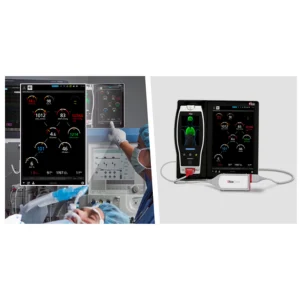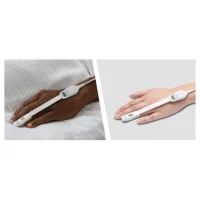LiDCO Offers Clinicians, for the First Time, a Board-in-Cable Solution Designed to Provide a More Complete Picture of Oxygen Delivery
Masimo announced the CE mark, under the European Union Medical Device Regulation, for the LiDCO® board-in-cable (BIC) module. The LiDCO BIC module is designed to connect to multi-patient monitoring platforms, like the Masimo Root® Patient Monitoring and Connectivity Hub, to provide advanced hemodynamic monitoring. With this solution, clinicians can easily add LiDCO hemodynamic monitoring – with its one-of-a-kind versatile PulseCO® algorithm – to their Root patient monitoring hubs. Like the PulseCO algorithm, the LiDCO module is pressure transducer agnostic, maximizing flexibility for clinicians and hospitals. For the first time, there is now a solution that can enable hemodynamic monitoring alongside other supported parameters without having a dedicated hemodynamic monitoring box. The LiDCO module supports everything from powerful guided protocols, designed to help assess fluid responsiveness, to rich trending data and notifications for beat-by-beat pressure analysis that can be displayed in the most helpful configurations for each patient on the Root monitor. Combining Masimo rainbow® Pulse CO-Oximetry and LiDCO hemodynamic monitoring brings the potential for significant new insights into patient status.
Joe Kiani, Founder and CEO of Masimo, said, “Bringing LiDCO’s beat-to-beat advanced hemodynamic monitoring to Masimo Root opens up the possibility of providing a more complete, continuous picture of cardiac output (CO) and oxygen delivery (DO2). Currently, hemodynamic monitors can provide continuous analysis of blood pressure information but rely on intermittent data from other monitors for oxygenation – giving clinicians only half of the information. Using both Masimo’s breakthrough noninvasive rainbow SET® Pulse CO-Oximetry parameters and LiDCO’s innovative PulseCO algorithm, clinicians now have the ability to view a continuous and simultaneous display of all the components that make up a patient’s oxygen delivery, DO2 – such as cardiac output (CO), stroke volume (SV), pulse rate (PR), total hemoglobin (Masimo SpHb®), and fractional oxygen saturation (Masimo SET® SpO2 adjusted for dyshemoglobins, SpCO® and SpMet®) – alongside an automated estimation of DO2. These can be displayed side by side, in real time and continuously, on Root’s high-resolution screen. We are excited about what this means for surgical and critical care patients whose clinicians can finally view real-time continuous data from the breakthrough combination of LiDCO and rainbow®, working synergistically together as an indication of continuous oxygen delivery.”
The LiDCO module is designed for efficient setup and simple, versatile operation, using a patient’s existing arterial line and blood pressure transducer to monitor a large list of advanced hemodynamic parameters using the powerful beat-by-beat PulseCO algorithm. The beat-by-beat analysis helps to provide more immediate feedback on fluid and hemodynamic status and avoid delays common with other hemodynamic monitors, which rely on assumptions about vascular compliance or detection of the dicrotic notch. Its streamlined board-in-cable design takes into account seamless compatibility with the Root monitor and other multiparameter platforms, removing the need to add a dedicated hemodynamic monitor to the already crowded OR and ICU space.
Dr. Max Jonas, Consultant in Intensive Care Medicine and Anesthesia at Southampton General Hospital in the U.K., said, “The introduction of the Masimo LiDCO Module is clinically very exciting, as it will deliver dynamic hemodynamic monitoring, with a known documented positive impact on patient outcome. The ability to provide individualized goal-directed therapy with calculated global oxygen delivery using LiDCO-derived cardiac output is clinically important. In my opinion understanding the individualized physiology of a particular patient is paramount to targeted treatments. Assessing preload, contractility and afterload using the LiDCO algorithm underpins patient management and the enhanced recovery after surgery (ERAS) process.”
Dr. Daniela Chaló, MD, PhD in Neurosciences, DESAIC, Head of Anesthesiology at Centro Hospitalar Baixo Vouga in Portugal, added, “The LiDCO monitor offers several advantages in hemodynamic monitoring. It is a plug-and-play solution, directly connected to the patient monitor or existing blood pressure transducer, without any disposables, compatible with various patient monitoring systems, helping healthcare providers to make better decisions.” Dr. Chaló continued, “The addition of LiDCO to the Root monitor – which also offers SpHb for hemoglobin monitoring and SedLine® and O3® for brain monitoring – means that all pertinent information can be available on one sole monitor. This is an extraordinary advancement for anesthesiology and intensive care. Root raises the standard of perioperative monitoring and is even bringing it to the artificial intelligence era. This is what we have all been waiting for.”
In clinical studies, use of LiDCO has been shown to reduce postoperative complications, costs, and even mortalities at 30 and 180 days after surgery. In a randomized, controlled trial of 743 patients undergoing major abdominal surgery, researchers found hemodynamic optimization with LiDCO led to a 20% reduction in postoperative complications and, as a result, patients monitored with LiDCO were on average $530 less expensive to treat than control patients who were not monitored.1 In another study that compared the outcomes of 600 emergency laparotomy patients, researchers found that, following the implementation of a program including LiDCO technology, there was a significant decrease in mortality at 30 days (from 21.8 to 15.5%) and 180 days (from 29.5 to 22.2%).2
The combination of LiDCO and Root may potentially have an even greater impact on the care paradigm.
A parameter as a measure of continuous oxygen delivery has not received FDA clearance and is not available in the U.S.
Source: Masimo
References
- Pearse R et al. Effect of a perioperative, cardiac output-guided hemodynamic therapy algorithm on outcomes following major gastrointestinal surgery: a randomized clinical trial and systematic review. JAMA2014; 311(21):2181-90.
- Tengberg LT et al. Multidisciplinary perioperative protocol in patients undergoing acute high-risk abdominal surgery. Br J Surg2017; 104:463-471.
- Published clinical studies on pulse oximetry and the benefits of Masimo SET® can be found on our website at http://www.masimo.com. Comparative studies include independent and objective studies which are comprised of abstracts presented at scientific meetings and peer-reviewed journal articles.
- Castillo A et al. Prevention of Retinopathy of Prematurity in Preterm Infants through Changes in Clinical Practice and SpO2 Technology. Acta Paediatr.2011 Feb;100(2):188-92.
- de-Wahl Granelli A et al. Impact of pulse oximetry screening on the detection of duct dependent congenital heart disease: a Swedish prospective screening study in 39,821 newborns. BMJ.2009;Jan 8;338.
- Taenzer A et al. Impact of pulse oximetry surveillance on rescue events and intensive care unit transfers: a before-and-after concurrence study. Anesthesiology. 2010:112(2):282-287.
- Taenzer A et al. Postoperative Monitoring – The Dartmouth Experience. Anesthesia Patient Safety Foundation Newsletter. Spring-Summer 2012.
- McGrath S et al. Surveillance Monitoring Management for General Care Units: Strategy, Design, and Implementation. The Joint Commission Journal on Quality and Patient Safety. 2016 Jul;42(7):293-302.
- McGrath S et al. Inpatient Respiratory Arrest Associated With Sedative and Analgesic Medications: Impact of Continuous Monitoring on Patient Mortality and Severe Morbidity. J Patient Saf. 2020 14 Mar. DOI: 10.1097/PTS.0000000000000696.
- Estimate: Masimo data on file.
- http://health.usnews.com/health-care/best-hospitals/articles/best-hospitals-honor-roll-and-overview.










